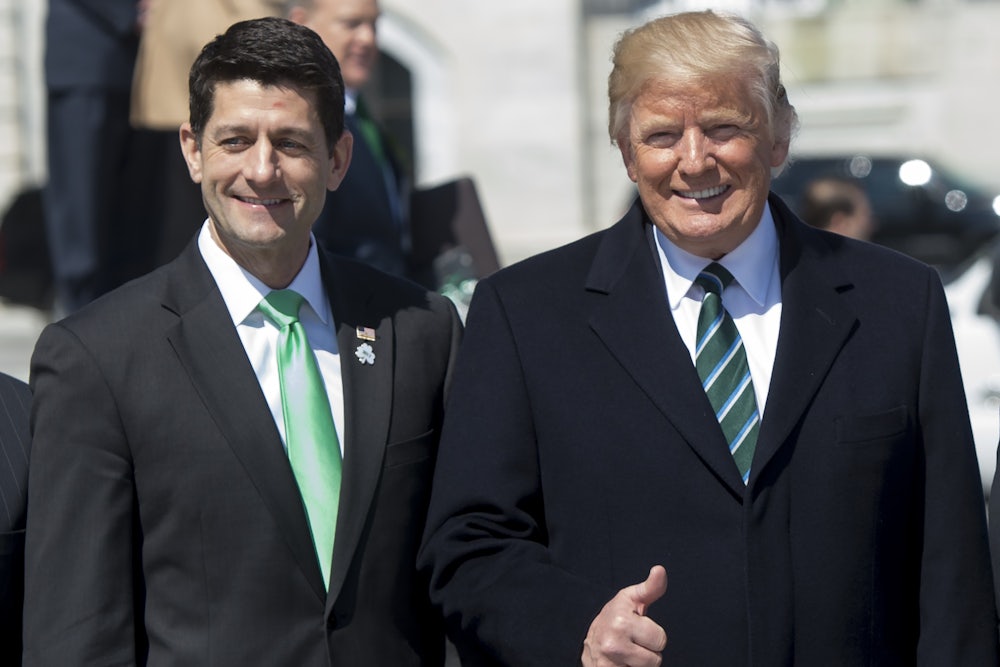In 2013, Paul Ryan declared that the war on poverty has “failed miserably” because of the country’s “high poverty rates.” In 2014, 50 years after Lyndon B. Johnson first coined the term, Ryan issued the House Budget Committee’s report on the war on poverty, stating, “Forty-seven million Americans live in poverty today. That’s 15 percent of our population—the highest in a generation.” In 2015, he claimed again, “After a 50-year war on poverty and trillions of dollars spent, we still have the same poverty rates.” Last year, Ryan’s A Better Way plan stated that “the official poverty rate in 2014 (14.8 percent) was no better than it was in 1966 (14.7 percent).”
Ryan has used the seemingly immutable poverty rate—along with the “earnest wonk” persona that he has created through a willing media—as proof that government social services have only hurt the poor and that Republicans genuinely want to help them. The idea that these services are actually bad has become a conservative mantra. And, for the first time since 2008, Ryan’s threats to destroy the welfare state won’t face the obstacle of a Democratic president, meaning that they have a serious chance of becoming law.
Fortunately for Ryan, Donald Trump is a pure distillation of the Republican Party’s libertarian extremism, not the freewheeling independent that the press has often made him out to be. Nowhere is this more evident than in Trump’s budget plan released in May. Trump’s spending blueprint consists of deep cuts into all of those failing social services—food stamps, the Earned Income Tax Credit, Temporary Assistance for Needy Families—derided by Ryan as wasted money. It was unsurprising, then, that when Trump released his budget, Ryan said that it was “right on the target” even as others in his party found the cuts too draconian.
Today, the Census Bureau released its annual report on poverty and income, data that gives us a deep glimpse into the economic state of our country. It shows that the official poverty rate dropped 0.8 percentage points from 2015 to 2016, to 12.7 percent, which is not statistically different from 2007, the last year before the recession. There is no doubt that conservatives like Ryan will skim off the top of the data to hammer the idea that government programs have failed to significantly dent the poverty rate, despite the “trillions” spent over the last 50 years.
The problem is that Ryan’s claims about the poverty rate are false. The headline poverty rate is a meaningless way to measure the effectiveness of government programs over time because it only accounts for cash benefits (like welfare) and not in-kind benefits (like food stamps and tax credits). The glaring problem with this arrangement is that, since the 1996 welfare reform bill, in-kind benefits like food stamps and refundable tax credits have become some of our country’s biggest anti-poverty programs, while cash benefits like welfare have shrunk.
In acknowledgment of this, the Census Bureau began releasing a supplemental poverty measure in 2011 that, among other technical improvements, accounts for nearly all cash and in-kind benefits. Researchers at Columbia University used the supplemental poverty measure to look at the effectiveness of government programs since 1967 and found that poverty fell from around 26 percent to 16 percent in 2012, a decrease of 40 percent.
Furthermore, the biggest anti-poverty program in our country is Social Security, a benefit that is counted by the official poverty measure. According to the Center for Budget and Policy Priorities, under the official measure, Social Security lifted 22 million people out of poverty in 2015. But this program’s success is conveniently ignored by Ryan when he derides the failure of the welfare state: Social Security is not mentioned a single time in his Better Way plan. (This doesn’t, however, mean that the program is safe from the GOP chopping block.)
According to the supplemental poverty measure released today, in 2016 refundable tax credits, SNAP, and housing subsidies lifted 8.2 million, 3.6 million, and 3.1 million people out of poverty, respectively. The supplemental poverty rate shows that 44.6 million people lived under the poverty line in 2016, but that 48.3 million more would be under the line without the full gamut of programs. (Once again, Social Security moved the most people—26.1 million—out of poverty).
While Ryan’s dubious use of the poverty rate has been rebutted by experts time and time again, this year’s Census numbers hold special urgency under the threat of the Trump administration. The Census poverty data starkly shows the damage the GOP could do to the country’s poor. Trump’s budget would cut SNAP by $192 billion and refundable tax credits by $40 billion over the next decade (the latter would be achieved by barring undocumented immigrants from collecting them). According to the Center for Budget and Policy Priorities, three-fifths of the cuts in Trump’s budget comes from programs that help the working class.
Trump and the GOP leadership will face enormous pushback from Democrats when the budget is taken up again in the coming months, not to mention from members of their own party. But the looming cuts to social programs are a greater threat than they have ever been. Trump’s budget might be extreme, but it is built on the foundation of lies spun by establishment conservatives like Paul Ryan. Today’s report puts numbers to how much the poor and working class would lose.
